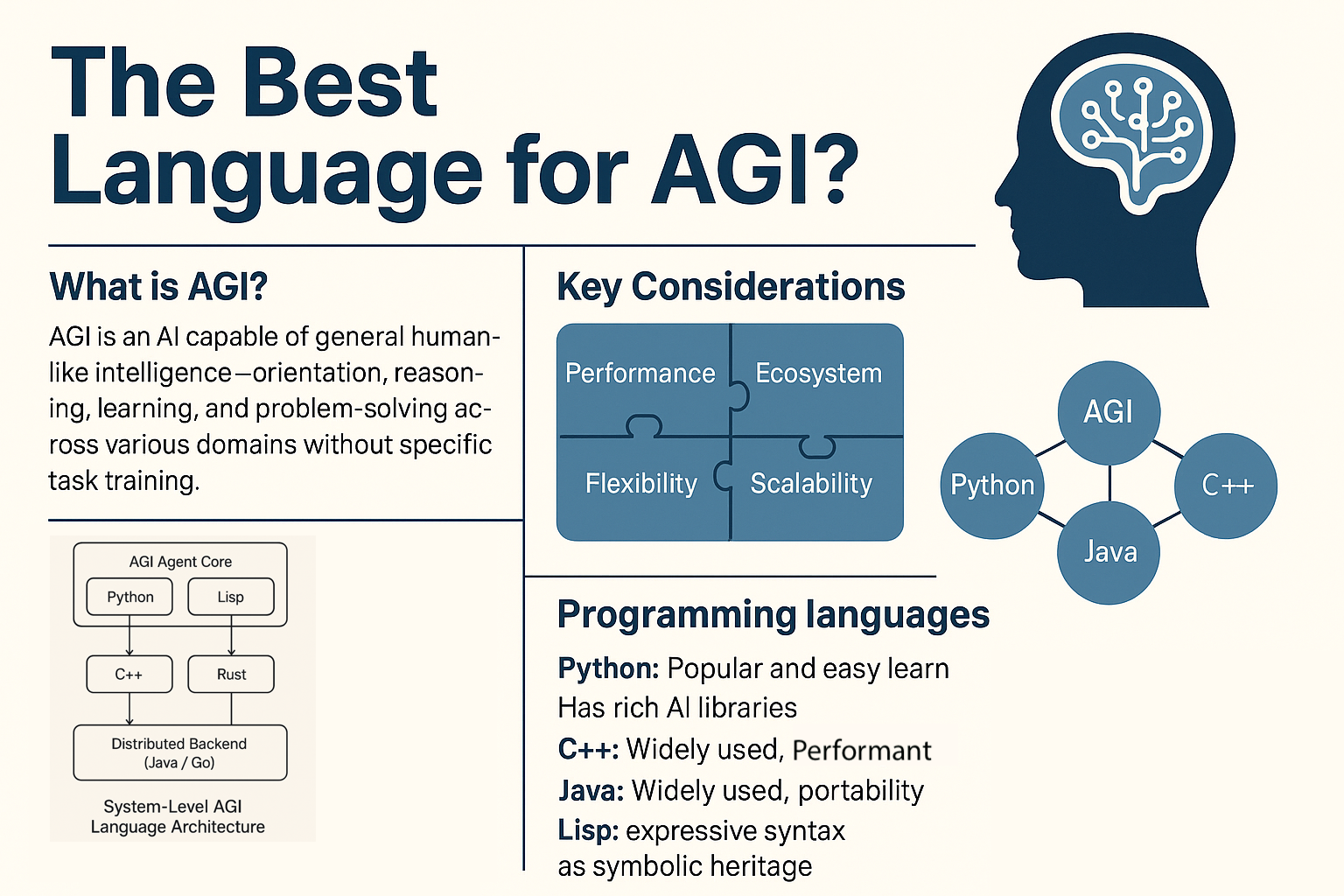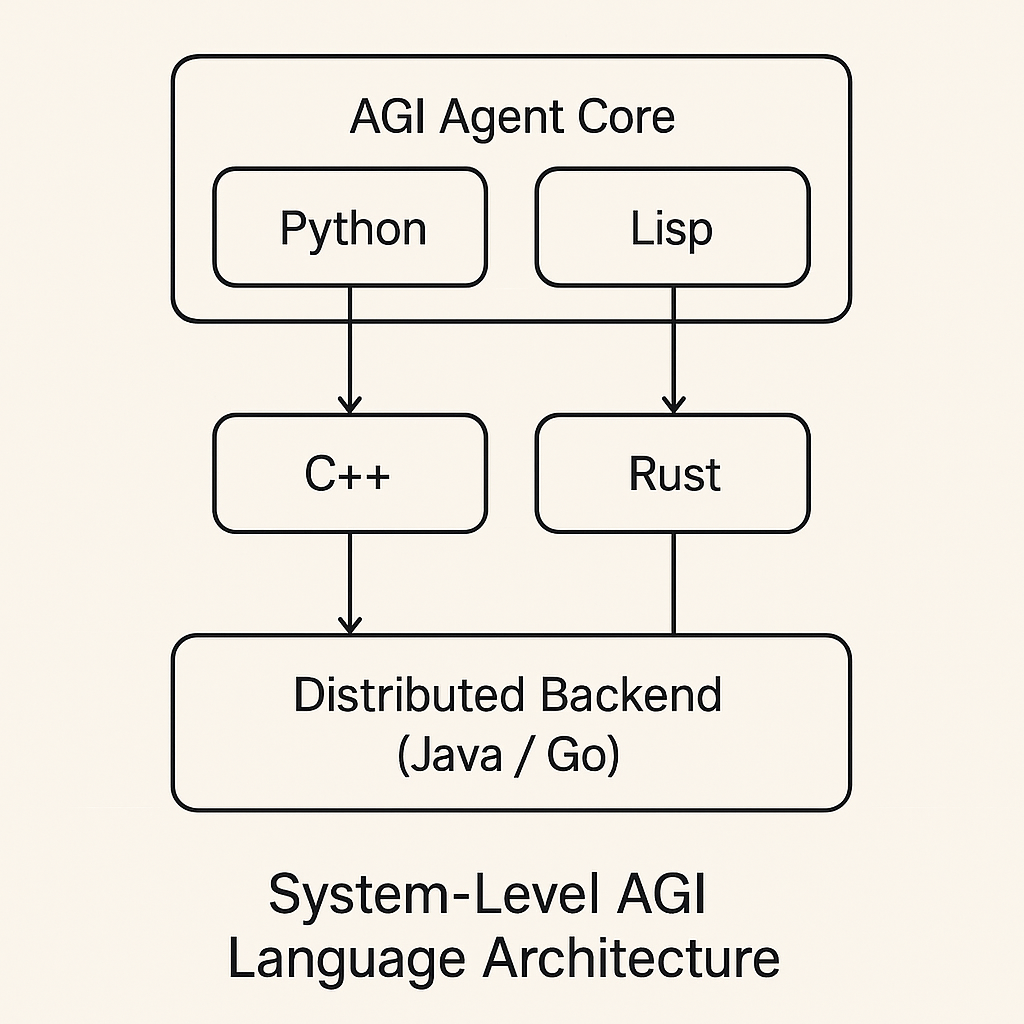The Best Language for AGI? A Technical Exploration

Artificial General Intelligence (AGI)—the elusive frontier of artificial intelligence—is the idea of creating machines capable of performing any intellectual task a human can. Unlike narrow AI, which excels at specific tasks like playing chess or classifying images, AGI must reason, plan, learn, adapt, and generalize across diverse domains.
But if you were to build AGI, what programming language would you choose?
This question is far from trivial. In this blog, we explore the trade-offs of different languages, why language choice matters in AGI development, and what characteristics a language must support to unlock the next generation of intelligence.
🌐 What Makes AGI Different?
AGI systems are expected to:
- Reason symbolically and statistically
- Continuously learn and generalize
- Interface with diverse environments
- Manage memory and context dynamically
- Optimize for both performance and introspection
No single language excels across all these requirements. Let’s break this down.
🔍 What Should We Look for in a Language for AGI?
Before evaluating specific programming languages for AGI, it’s important to define the ideal characteristics such a language should support:
- Expressiveness: Enables representation of complex mental models and evolving knowledge structures.
- Runtime Introspection: Allows the system to examine and modify its own code and behavior during execution.
- Concurrency Support: Facilitates handling of asynchronous inputs from real-world environments.
- Performance: Ensures fast training, simulation, and inference across large-scale data and processes.
- Symbolic and Numeric Fusion: Seamlessly integrates logic-based reasoning with neural learning approaches.
- Ecosystem: Offers access to robust libraries, AI frameworks, and tooling infrastructure.
- Meta-programming: Supports code generation, transformation, and dynamic reconfiguration as part of the intelligence model.
With these criteria in mind, we can now explore which languages best align with the goals of AGI development.
🐍 Python: The Dominant AI Language
Pros:
- Rich ecosystem (PyTorch, TensorFlow, Hugging Face)
- Easy to prototype ideas quickly
- Seamlessly integrates symbolic tools (SymPy, NLTK) and numeric computing (NumPy, JAX)
- Strong community and academic support
Cons:
- Poor performance in CPU-bound tasks
- Weak in concurrency and memory management
- Lacks advanced meta-programming beyond
eval()and decorators
Use Case: Ideal for prototyping, research, and building hybrid AGI frameworks (e.g., neural-symbolic models).
⚙️ C++: The Performance Titan
Pros:
- Speed, memory control, and fine-grained optimization
- Used extensively in deep learning frameworks and real-time systems
- Strong concurrency and parallelism support
Cons:
- Verbose and difficult for rapid experimentation
- Lack of introspection, dynamic typing, and meta-level reasoning tools
Use Case: Useful for performance-intensive AGI modules (e.g., real-time learning, multi-agent simulation).
☕ Java: The Enterprise Bridge
Pros:
- Mature threading and memory model
- Great portability and stability
- Useful for distributed, scalable AGI backends (e.g., actor-based AGI agents)
Cons:
- Lacks flexibility for symbolic reasoning and metaprogramming
- Verbose syntax inhibits experimentation
Use Case: Useful in large-scale AGI platforms requiring high uptime, logging, and service architecture.
🧠 Lisp / Clojure: The Symbolic DNA
Pros:
- Code is data (homoiconicity) — ideal for introspective AGI
- First-class symbolic processing support
- Supports rule-based, logic-driven systems elegantly
Cons:
- Smaller ecosystem for machine learning
- Poor performance for high-throughput numerical tasks
Use Case: Ideal for modeling memory, symbolic reasoning, self-reflective processes, and metacognition in AGI.
🧩 Diagram: Language Suitability Grid
Here's a technical comparison matrix:
+------------------+-------------+------------+------------+---------------+-----------------+ | Language | Performance | Symbolic | Meta-prog | Concurrency | Ecosystem | +------------------+-------------+------------+------------+---------------+-----------------+ | Python | Medium | Medium | Medium | Low | Excellent | | C++ | Excellent | Low | Low | High | Good | | Java | High | Low | Low | High | Very Good | | Lisp / Clojure | Medium | Excellent | Excellent | Medium | Niche | +------------------+-------------+------------+------------+---------------+-----------------+
🧬 Hybrid Architectures: It’s Not Either-Or
No serious AGI project uses just one language. Instead, we’re increasingly seeing polyglot systems. For example:
- A Python front-end for training and experimentation
- C++ back-end for high-performance model inference
- Lisp/Clojure module for symbolic processing and self-reflective planning
- Rust or Go for secure distributed agent frameworks
AGI is an inherently multi-modal and multi-paradigm system. Programming languages, like cognitive modules, must cooperate.
📈 Cutting-Edge Language Contenders
1. Julia – Promising for scientific AGI
- Combines Python-like syntax with C-like speed
- Strong in linear algebra and differentiable programming
2. Rust – Secure, high-performance systems
- Safe concurrency model
- Ideal for building fault-tolerant AGI infrastructure
3. Prolog – Symbolic logic native
- Excellent for knowledge representation, planning, and inference
- Hard to integrate with modern ML stack
📐 Diagram: System-Level AGI Language Architecture
Edit
+-----------------------------+
| AGI Agent Core |
| +--------+ +-----------+ |
| | Python | | Lisp | | <-- Perception, Reasoning, Reflection
| +--------+ +-----------+ |
| | | |
| v v |
| +--------+ +----------+ |
| | C++ | | Rust | | <-- Performance, Control, Memory Safety
| +--------+ +----------+ |
+-------------|-------------+
v
Distributed Backend (Java / Go)
🧠 What Language Would an AGI Choose?
Let’s pose a thought experiment: if an AGI could select its own programming language, what would it value?
- Self-modifiability
- Semantic clarity
- Adaptive learning libraries
- Interface with logic and probability
- Portability and performance
A Lisp-Python hybrid with native JIT and concurrency primitives may be the closest answer.
🏁 Conclusion: There Is No One Language But A Mix
AGI is not just about intelligence—it’s about integration. No language can satisfy all needs of AGI development. Instead, the best approach is language orchestration, where symbolic, statistical, and architectural concerns are handled by specialized modules written in the most suitable language.
If you’re building toward AGI, choose a stack that matches your cognitive architecture:
- Python for prototyping, neural models
- C++ for speed-critical layers
- Lisp or Prolog for symbolic inference
- Rust/Go for backend resilience

In the quest for AGI, your language matters—but your design matters more.
Let me know if you'd like know more about how we implement AI to your operations.
- Schedule a Discovery Call
- Email us directly: contact@adenhq.com